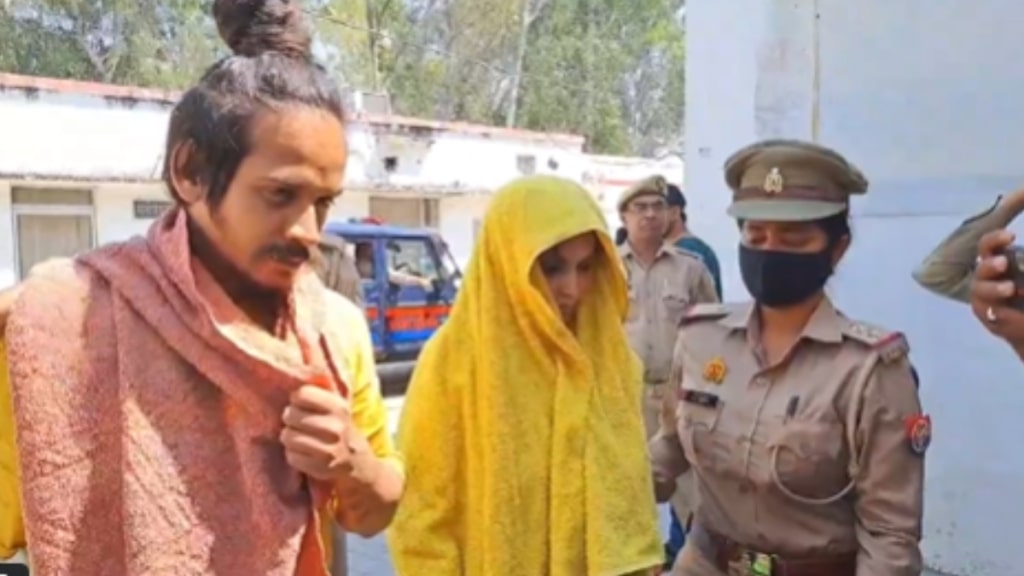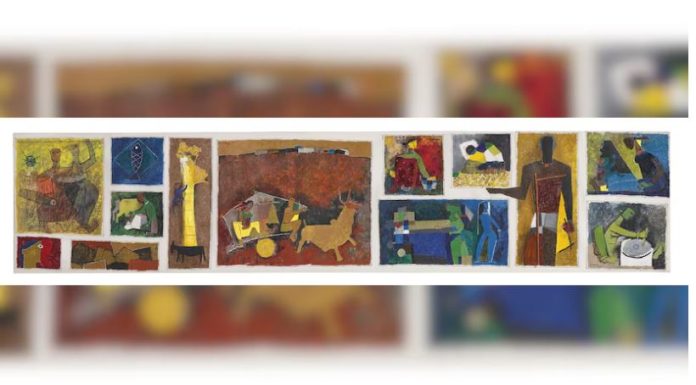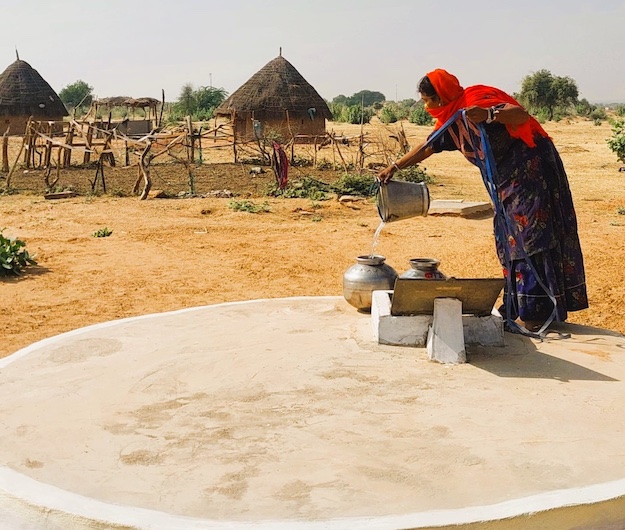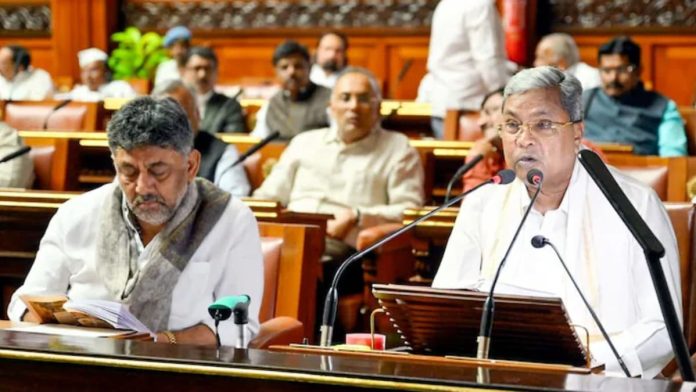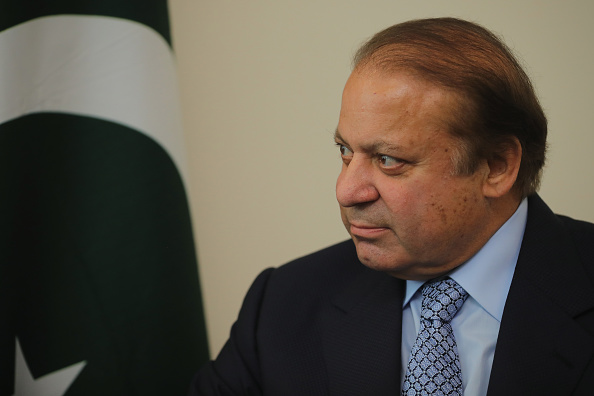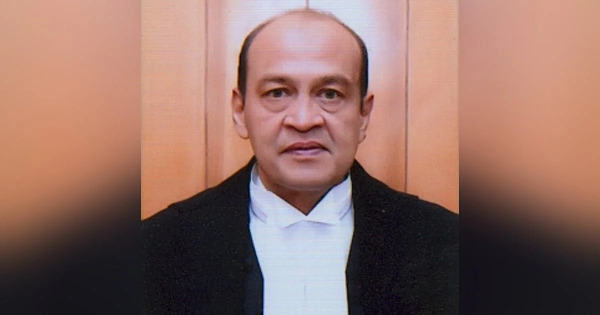M.F. Husain’s Painting Gram Yatra Breaks Records, Sells for Rs 118 Crore at Christie’s Auction
A monumental painting by legendary Indian artist Maqbool Fida Husain, titled Untitled (Gram Yatra), has set a new record for Modern Indian Art, fetching an astonishing $13.7 million (around Rs 118 crore) at a Christie’s auction in New York on March 19. This sale not only marks a significant achievement in the art world but also makes it the first Indian artwork to cross the Rs 100 crore mark at auction.
The painting, created in 1954, is a vivid tribute to rural India, capturing 13 distinct vignettes depicting life in the countryside. Measuring nearly 14 feet in length, it was originally showcased at the All India Fine Arts & Crafts Society (AIFACS) exhibition in New Delhi in 1954. After being acquired by Norwegian doctor Leon Elias Volodarsky, it remained in Europe for decades, largely out of the public eye. Volodarsky, an avid art collector, bought the piece for just 1,400 rupees, a modest sum compared to its current value.
Indian Art Market Witnesses Historic Surge
Following Volodarsky’s death, the painting was donated to Oslo University Hospital in 1964, where it hung in a private corridor for years. The work finally surfaced at Christie’s auction house after a tip-off about its location, and the rest, as they say, is history. The sale was a fierce bidding war, with Indian art collector and philanthropist Kiran Nadar reportedly acquiring the piece after a heated contest.
The previous record for a Husain painting was $3.1 million (about Rs 26 crore) for Untitled (Reincarnation), sold last year. The staggering price of Gram Yatra represents a 450% increase in Husain’s auction value, signaling a significant shift in the art market. Experts predict this will influence the pricing of Indian art across the board, boosting the confidence in the country’s art scene.
History of the Painting
Husain, one of India’s most celebrated modern artists, was a founding member of the Progressive Artists’ Group, established in 1947 to break free from European artistic traditions and create a new, uniquely Indian form of modern art. His works, often characterised by vibrant colors, bold figures, and a fusion of cubist and folk styles, continue to inspire and attract attention globally.
Art historians describe Gram Yatra as a critical piece in Husain’s career, exemplifying his signature boldness, bright palette, and unique narrative style. The sale of this iconic painting has not only elevated Husain’s standing but also placed a spotlight on the growing market for Indian art, signaling greater recognition for artists from the region. This sale is a true “homecoming” for Husain and his work, as it finally receives the recognition it deserves on the global stage.
CSR News: Initiative Drives Water-Secure Future for Drought-Prone Villages and Disadvantaged Communities through WASHE programme
On World Water Day, Standard Chartered Bank, India, announced its plan to make total of 32 districts water secure by end of 2027 through its focussed efforts on providing clean water access, sustainable solutions and education while making a transformative change in the community.
The Bank, as part of this initiative, will build additional 1,253 water harvesting structures to benefit over 9000 households across India helping them get clean drinking water. The initiative is present in Chhattisgarh, Delhi, Gujarat, Haryana, Jharkhand, Karnataka, Ladakh, Madhya Pradesh, Maharashtra, Odisha, Punjab, Rajasthan, Tamil Nadu, Uttar Pradesh, Uttarakhand and West Bengal.
Standard Chartered Bank, through its WASHE (Water, Sanitation, Hygiene and Education) programme has been committed to create a water-secure future for communities in drought-prone areas with strategic scientific support and integrated water resource management. The programme spreads across difficult topographies and terrains from enhancing water availability through spring shed management and artificial glaciers in Ladakh and Uttarakhand to leveraging on hyper local innovations for water harvesting in drought prone areas of Rajasthan.
The WASHE programme currently supports 369 drought-prone villages across multiple states by providing essential access to clean and safe drinking water. With a capacity to generate 1.3 billion litres of freshwater annually, the Bank has aided construction of 2,899 water harvesting structures to support over 1.5 million people in these regions, including 700,000 women. This integrated approach addresses both immediate water needs and long-term development goals, ensuring the sustainability of water resources for future generations.
A key achievement in the Bank’s efforts is the establishment of 135 solar-powered water ATMs (water vending machines) in Maharashtra, Rajasthan, Punjab, Uttar Pradesh and Madhya Pradesh, which provide clean drinking water to approximately 2,000 families per unit. These ATMs have revolutionised water access, particularly for communities at risk due to water contamination. These efforts have also positively generated water-based livelihoods for the community and created many water entrepreneurs.
With a focus on environmental sustainability and youth empowerment, WASHE initiatives also treats grey water, with an annual capacity of 500 million litres in Madhya Pradesh and Chhattisgarh.
WASHE programme, so far has enabled irrigation of 2,830 hectares of land, benefiting local farmers and improving agricultural productivity in Maharashtra, Rajasthan, Gujarat, Madhya Pradesh and Tamil Nadu. Additionally, it has trained over 40,000 youth, women and community workers to actively engage in water conservation and sustainable agricultural practices in West Bengal, Odisha, Andhra Pradesh and Madhya Pradesh.
Speaking at the occasion, Karuna Bhatia, Head of Sustainability, India, Standard Chartered Bank, said, “At Standard Chartered, we believe that access to clean water is a fundamental right that drives social and economic progress. Through WASHE, the Bank has made a significant impact in several drought-prone villages by not only addressing immediate water needs but also empowering communities through education, youth engagement, and sustainable resource management.
This programme exemplifies the Bank’s dedication to improving the lives of the people and building a water-secure future for millions of people. With plans to extend its impact by constructing more water harvesting structures, we will continue to uplift communities and foster long-term resilience in regions affected by water scarcity and contamination,” Karuna Bhatia added.
Disclaimer: This media release is auto-generated. The CSR Journal is not responsible for the content.
Karnataka Passes 4% Muslim Quota Bill; BJP MLAs Protest, Tear Copies
The Karnataka Legislative Assembly on Friday passed a bill leading to protests from the BJP leaders. The bill proposes a 4% reservation for Muslim contractors in state’s government tenders. The move was introduced by the Siddaramaiah-led Congress government, However the bill sparked a heated political debate in the assembly. The BJP leaders called it “unconstitutional” and further vowed to challenge it in court.
BJP Protests
The bill was passed amidst the honey trap scandal that has rocked Karnataka politics. Following the passage of the bill, a massive uproar erupted in the Karnataka Assembly. As the Congress government moved forward with the reservation bill, the BJP leaders stormed in the well of the House.
Soon the BJP leaders started chanting slogans, and even climbed onto the Speaker’s seat. Not just that in a very dramatic escalation, the BJP members tore copies of the bill and hurled them toward the Speaker, expressing their fierce opposition over the bill.
Karnataka Assembly adjourned following ruckus in House
Read @ANI Story | https://t.co/nQ7TiKoMkP#Karnataka #Adjourned #Assembly #BJP #Congress pic.twitter.com/r4rrQZMBsE
— ANI Digital (@ani_digital) March 21, 2025
Furthermore, the BJP MLA Bharath Shetty justified the protest, stating, “Instead of discussing the honey trap scam, the Chief Minister was busy presenting the four per cent Muslim bill and hence we protested. The government MLAs also tore papers and threw books at us; we didn’t harm anybody.”
The Congress Defends Reservation
Meanwhile, the Congress government defended the bill. The party stated that the 4% quota for Muslim contractors was aimed at ensuring social justice. They also claimed that it will provide economic opportunities for minorities. Following this the Karnataka Chief Minister Siddaramaiah also backed the decision. He stated that the move aligns with his government’s commitment to inclusive development and affirmative action.
However, the bill did not sit well with the BJP. They strongly opposed the bill, calling it appeasement politics. The party further accused the Congress of diverting attention from more pressing issues like the ongoing honey trap scandal.
What is the Honey Trap Scandal?
Well, all the trouble began with the Honey Trap Scandal. The Assembly session was already tense and heated due to Cooperative Minister KN Rajanna’s disclosure about a honey trap scandal. The BJP leaders held up CDs, alleging them to be evidence of blackmail and entrapment. These revelations further escalated tensions in the House.
What does KN Rajanna say?
Rajanna stated, “Many people say Karnataka has become a CD and pen drive factory. This is a serious allegation. It is being said that two influential ministers from Tumakuru have been caught in a honey trap. The ones from Tumakuru are G Parameshwara and me.”
“I will file a complaint. The Home Minister must investigate this matter. Let the producers and directors of this be caught. Let the public know who is behind this,” Rajanna said.
Now the BJP is planning a legal challenge against the bill. Meanwhile, the controversy surrounding both the reservation policy and the honey trap scandal will be watched closely,
Climate Change Could Triple Heart-Related Diseases in Next 25 Years: Study
A recent study has highlighted the devastating impact of climate change on cardiovascular health. It has issued a warning that heart-related diseases could increase two to threefold over the next 25 years if current climate trends persist. This stark prediction underscores the urgent need for action to mitigate the effects of global warming on human health.
Australian researchers have revealed that nearly 49,500 years of healthy life are lost annually due to heart disease linked to high temperatures. They caution that the repercussions of severe weather events are set to escalate in the coming decades if climate patterns remain unchanged.
The Heart-Climate Connection
The study, published in the European Heart Journal, utilised data from the Australian Burden of Disease Database to examine the effects of cardiovascular disease from 2003 to 2018. Professor Peng Bi from the University of Adelaide explained, “During hot weather, our hearts need to exert more effort to regulate body temperature. This additional strain can be perilous, particularly for individuals with existing cardiovascular conditions”.
The research team estimated that 7.3 per cent of the overall burden associated with cardiovascular diseases or fatalities can be linked to extreme weather phenomena. Their modelling indicates that this percentage could potentially double or triple by 2050, depending on various greenhouse gas emission scenarios.
Global Implications and Vulnerable Populations
While the study focused on Australia, the fundamental correlation between rising temperatures and heightened cardiovascular risks has been recognised globally. A meta-analysis of studies worldwide showed that a 1°C increase in temperature was significantly associated with a 0.5 per cent increase and a 2.1 per cent increase in cardiovascular disease-related morbidity and mortality, respectively.
Older adults, racial and ethnic minorities, and lower-income communities are disproportionately affected by these climate-related cardiovascular risks. This disparity highlights the need for targeted interventions and support for vulnerable populations.
The impact of climate change on heart health extends beyond temperature increases. Extreme weather events such as hurricanes, cyclones, and tropical storms have also been linked to increased risk of heart disease. These events can disrupt healthcare delivery through power outages and supply chain disruptions, further compromising cardiovascular health.
As global temperatures continue to rise, with the world experiencing the highest temperatures in over 100,000 years in 2023, the urgency to address this looming health crisis becomes ever more apparent. The Australian Medical Association has formally declared climate change as a health emergency, emphasising the need for immediate action.
Health professionals worldwide agree that climate change is real, human-caused, and is causing increased health problems in their communities. They can play a crucial role by informing people about health risks and ways to address them, lobbying leaders to take action, and taking steps to decarbonise their own homes and workplaces.
As we face this growing threat to cardiovascular health, it’s clear that addressing climate change is not just an environmental issue, but a critical public health concern. Urgent action is needed to mitigate climate change-associated cardiovascular risk, particularly among our most vulnerable populations. The health of our hearts – and indeed, our very lives – may depend on it.
Merchant Navy Officer’s Death in Meerut: Saurabh’s Body Chopped, Packed in Drum with Cement by wife and her boyfriend
Uttar Pradesh Police has revealed spine-chilling details regarding the murder of Merchant Navy officer Saurabh Rajput in Meerut allegedly by his wife Muskan Rastogi and her boyfriend Sahil Shukla. The case has also raised questions on the mental health of the duo who have confessed to their crime.
The 29-year-old Merchant Navy officer Saurabh Rajput was brutally murdered by his wife Muskan Rastogi and her boyfriend and co-accused Sahil Shukla (both 27), in Uttar Pradesh’s Meerut on March 4 after which his body was cut into pieces and hidden in a drum filled with cement by the duo who were planning to get married and considered Saurabh as an “obstacle” to their relationship.
Muskan Rastogi and boyfriend Sahil Shukla in jail
Muskan Rastogi and her boyfriend Sahil Shukla who have confessed to murdering and dismembering Saurabh Rajput have been arrested by the Uttar Pradesh Police. On Wednesday, the two accused were remanded to 14-day judicial custody by the court of the chief judicial magistrate. Outside the court, a group of lawyers, who enraged by the crime, physically attacked them.
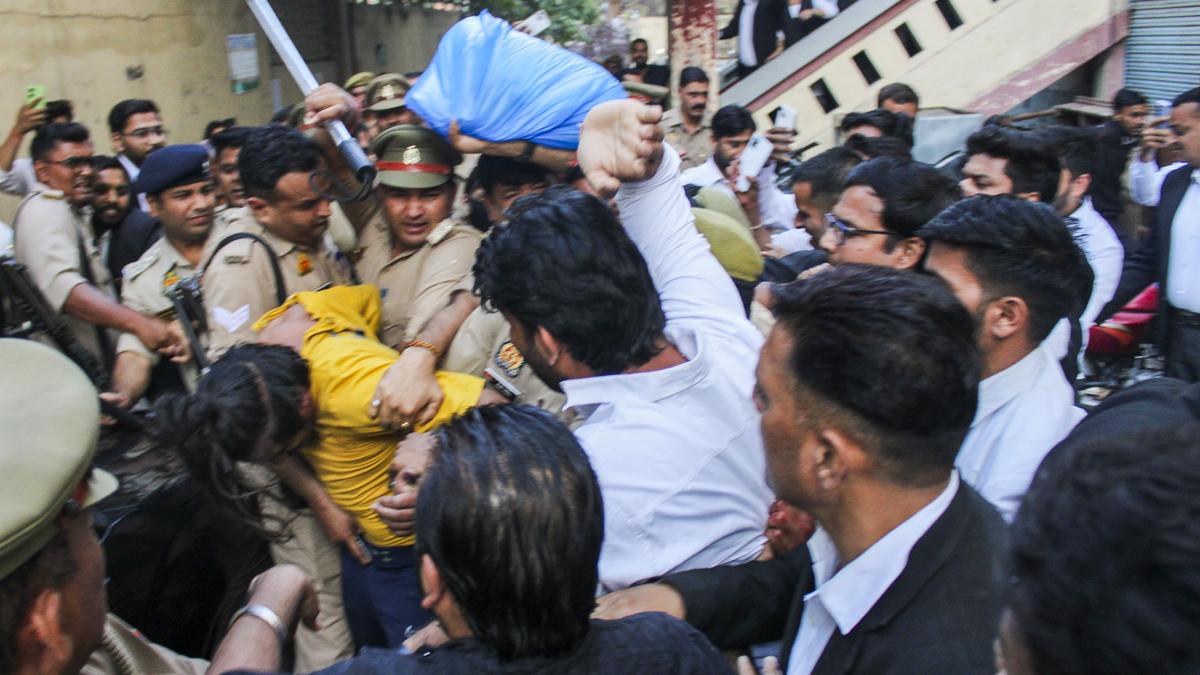
As per the police, the duo displayed restless behaviour at night in Chaudhary Charan Singh district jail in Meerut, showing signs of distress. While Muskan has been kept in the women’s barrack, co-accused Sahil Shukla has been lodged separately in the men’s unit. Senior jail superintendent Viresh Raj Sharma has revealed that after coming to the jail Muskan kept quiet, cried at night and refused food. The duo had reportedly requested to be kept in adjacent barracks, but their request was denied.
How the murder was was planned?
As per police, the love affair started in 2019 after school buddies Muskan and Sahil were reunited with each other at a reunion hosted by their school group at a mall in Meerut. As per the police, the two bonded over drugs as they used to consume narcotics together. This bond grew stronger due to the absence of Muskan’s husband who was posted in London.
As the romance grew deeper, the lovers started considering Muskan’s husband Saurabh as an ‘obstacle’ to their relationship after which they started planning the cold blooded murder in November last year.
On February 22, Muskan bought two knives for Rs 800 telling the storekeeper that she needs the same to cut chicken. She also had faked anxiety to a doctor and obtained sleeping pills with plans to sedate her husband before killing him.
Police has revealed that from purchasing knives to getting sedatives and checking out various locations to dispose of the dead body, Muskan and Sahil had very carefully planned the cold blooded murder.
